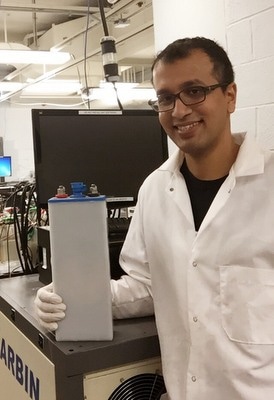Mar 3 2017
 Gautam Yadav with the low cost, rechargeable high energy density battery developed at CCNY's Grove School of Engineering. (Credit: The City College of New York)
Gautam Yadav with the low cost, rechargeable high energy density battery developed at CCNY's Grove School of Engineering. (Credit: The City College of New York)
A team of researchers at The City College of New York-based CUNY Energy Institute have developed a novel economical, rechargeable, high energy density battery that will soon facilitate the extensive use of wind and solar power. The battery is based on manganese dioxide (MnO2), a material that is abundant, safe, and non-toxic.
The researchers describe the battery’s uniqueness in a paper in the Nature Communications journal, stating that it is capable of realizing both high areal capacity and high cycle life.
In order to pack a number of battery electrodes together into a battery case, it is important to achieve high areal capacity. Essentially, this means that high areal capacity is required to construct a real, practical battery, as opposed to a tiny toy battery.
In the past, researchers have attained either high areal capacity or high cycle life, but have never achieved both together, the team emphasizes.
This unique innovation was possible by intercalating copper (Cu) into bismuth-modified δ-MnO2, which is called birnessite. In the 1980s, the latter was discovered by Ford Motor Company, but no one knew how to use it at high areal capacity. a research team led by Sanjoy Banerjee, renowned Professor and director of the Institute discovered the use at the CUNY Energy Institute.
The battery is projected for use at the scale of the power grid. This, in turn, would make it possible for wind and solar power to be used extensively.
An Advanced Research Projects Agency-Energy (ARPA-E) grant from the Department of Energy financially supported this research.
CCNY research associate Gautam Yadav is the chief inventor and lead author of the articles. The other researchers were Joshua Gallaway, Damon Turney, Michael Nyce, Jinchao Huang, and Xia Wei.
Further Reading
- "Regenerable Cu-intercalated MnO2 layered cathode for highly cyclable energy dense batteries", G. Yadav et al, Nature Communications 2017, DOI:10.1038/ncomms14424